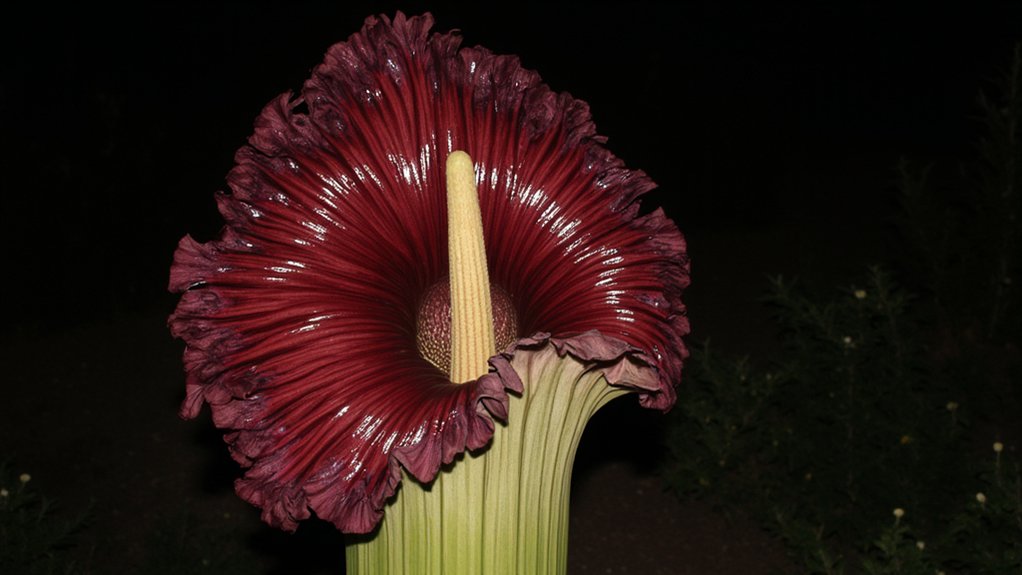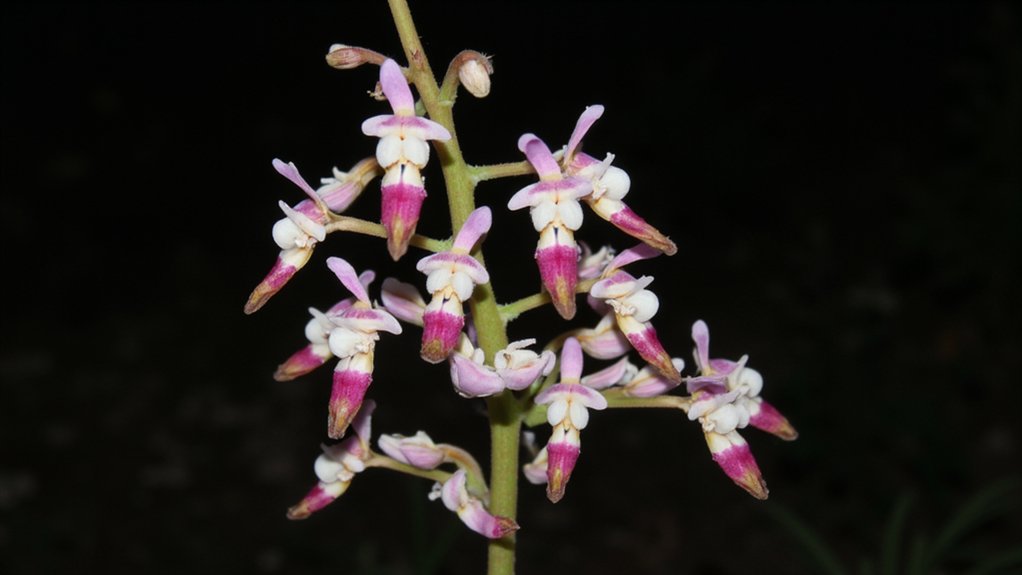You’re about to discover some of nature’s most peculiar botanical creations that challenge everything you know about flowers. While roses and daisies might dominate garden beds worldwide, a hidden domain of bizarre blooms exists, from orchids that perfectly mimic flying ducks to flowers that smell like rotting flesh. These strange specimens demonstrate nature’s capacity for the extraordinary, and what you’ll learn about them might change your perspective forever.
Contents
- 1 The Duck Orchid: Nature’s Living Bird Illusion
- 2 Corpse Flower: The Malodorous Giant
- 3 Naked Man Orchid: Human-Shaped Blooms
- 4 Ghost Orchid: The Ethereal Phantom
- 5 Monkey Face Orchid: Primate Mimicry in Plants
- 6 Bat Flower: Gothic Beauty in Black
- 7 Crystal Flower: The Glass-Like Marvel
- 8 Snapdragon Seed Pods: Skulls in the Garden
- 9 Flying Duck Orchid: Nature’s Aerial Performer
- 10 Snake’s Head Fritillary: The Checkered Wonder
The Duck Orchid: Nature’s Living Bird Illusion

When you first glimpse the Duck Orchid, you’ll understand why it earned its peculiar name. This Australian native, Caleana major, features a head, neck, and body that precisely mirror a duck in mid-flight, complete with glossy brown-purple coloring.
You’ll find this clever mimic growing in eastern and southern Australia, where it blooms between September and January. The flower’s hinged “beak” actually serves as a trap for male sawfly pollinators, temporarily capturing them to guarantee successful pollination.
Each Duck Orchid stands about 20 inches tall, with individual flowers measuring roughly 1.5 inches across, making this deceptive bloom a small but remarkable example of nature’s artistry.
Corpse Flower: The Malodorous Giant

Although you might expect the world’s largest unbranched flower to be beautiful, the Amorphophallus titanum assaults your senses with the putrid smell of rotting flesh. You’ll find this remarkable plant, commonly known as the corpse flower, reaching heights of up to 10 feet when it blooms in its native Sumatra.
You won’t see this flower often, as it takes 7-10 years to produce its first bloom, which lasts only 24-36 hours. During this brief window, the spadix heats up to human body temperature, helping to spread its distinctive carrion scent that attracts pollinating insects like flies and beetles.
Naked Man Orchid: Human-Shaped Blooms

Growing in clusters along Mediterranean hillsides, the Orchis italica displays dozens of tiny flowers that remarkably resemble rows of small humanoid figures. Each pink-purple bloom, measuring just 2-3 centimeters, features petals and sepals that form a distinct head, torso, and limbs.
You’ll find these whimsical orchids blooming between March and May, with each stem producing 20-40 individual “figures.” The plant reaches heights of 20-50 centimeters, and while it’s native to the Mediterranean region, you can now spot it in similar climates worldwide.
These orchids prefer well-draining, alkaline soil and partial shade to thrive properly.
Ghost Orchid: The Ethereal Phantom
The mysterious ghost orchid earned its name from its ethereal white blooms that appear to float in mid-air. You’ll find this rare flower clinging to tree bark in Florida’s swamps and Cuba’s forests, where its roots create a web-like pattern against the dark surface.
When you spot a ghost orchid, you’re witnessing a flower that blooms for just two weeks each year. Its delicate white petals stretch up to 5 inches across, while two long, twisted tendrils can extend 12 inches below the bloom.
Scientists have documented fewer than 2,000 ghost orchids in the wild, making each sighting a truly remarkable event.
Monkey Face Orchid: Primate Mimicry in Plants
Nature’s sense of whimsy shines through in the monkey face orchid, a remarkable flower found high in the cloud forests of southeastern Ecuador and Peru. The scientific name, Dracula simia, refers to both its monkey-like appearance and the two long, fang-like petals that extend downward.
You’ll recognize this orchid instantly by its fuzzy, round center, which bears an uncanny resemblance to a tiny primate’s face. The center disc features dark eyes, furry eyebrows, and a distinct nose, while reddish-brown “fur” completes the monkey-like appearance. Even more intriguing, these orchids emit a subtle scent of ripe oranges.
Bat Flower: Gothic Beauty in Black
Moving from primate-mimicking orchids to darker botanical wonders, you’ll find Tacca chantrieri, commonly known as bat flowers, displaying their dramatic black petals like wings in the shadows of Southeast Asian forests.
These unusual blooms reach up to 12 inches across, with whisker-like bracts that can extend 28 inches. You’ll notice their deep purple-black flowers emerge from long stalks between March and June, creating an almost theatrical display in the understory.
If you’re hoping to grow these gothic beauties, they’ll need high humidity, temperatures above 70°F, and well-draining soil rich in organic matter.
Crystal Flower: The Glass-Like Marvel
During dry conditions, the flower’s petals appear solid white, measuring about 4 inches across. When moisture hits, tiny spaces between the flower’s cells fill with water, creating the stunning glass-like effect. You’ll find similar species in Japan and the Appalachian Mountains, though Chile’s variant displays the most dramatic transformation.
Once the rain stops, the petals gradually return to their opaque state within 30 minutes.
Snapdragon Seed Pods: Skulls in the Garden
While snapdragons delight gardeners with their colorful blooms in spring, their dried seed pods create an entirely different spectacle. Once the flowers fade, they transform into eerie, skull-shaped capsules that’ll make you do a double-take.
These macabre pods, measuring about half an inch long, feature distinctive eye sockets and a jaw-like structure that splits open when mature. You’ll find tiny black seeds inside, which you can collect and store for next season’s planting.
The scientific name, Antirrhinum majus, comes from the Greek words meaning “nose-like,” though it’s the pods’ resemblance to miniature skulls that’s earned them their spooky reputation among gardeners.
Flying Duck Orchid: Nature’s Aerial Performer
Few orchids capture the imagination quite like Australia’s Flying Duck Orchid (Caleana major), a remarkable flower that bears an uncanny resemblance to a duck in mid-flight. You’ll find this tiny marvel, measuring just 1-2 centimeters across, growing in eastern and southern Australia’s woodlands from September to January.
When you look closely, you’ll notice the flower’s hinged labellum forms the duck’s head and body, while the column wings create its feet. The genius of this design isn’t just aesthetic – it’s functional. When a male sawfly lands on the labellum, it triggers a trap mechanism that temporarily holds the insect for pollination.
Snake’s Head Fritillary: The Checkered Wonder
Nature’s checkerboard comes to life in the Snake’s Head Fritillary (Fritillaria meleagris), a distinctive spring flower that’s instantly recognizable by its unique purple and white checkered pattern.
You’ll find these unusual blooms nodding on slender 12-inch stems between March and May. The bell-shaped flowers, measuring about 2 inches across, display an intricate tessellation that resembles snakeskin or a chess board.
While they’re native to European meadows, you can grow these hardy perennials in your garden. Plant the bulbs 4 inches deep in early autumn, spacing them 4-6 inches apart in well-draining, slightly acidic soil. They’ll multiply naturally over time.
